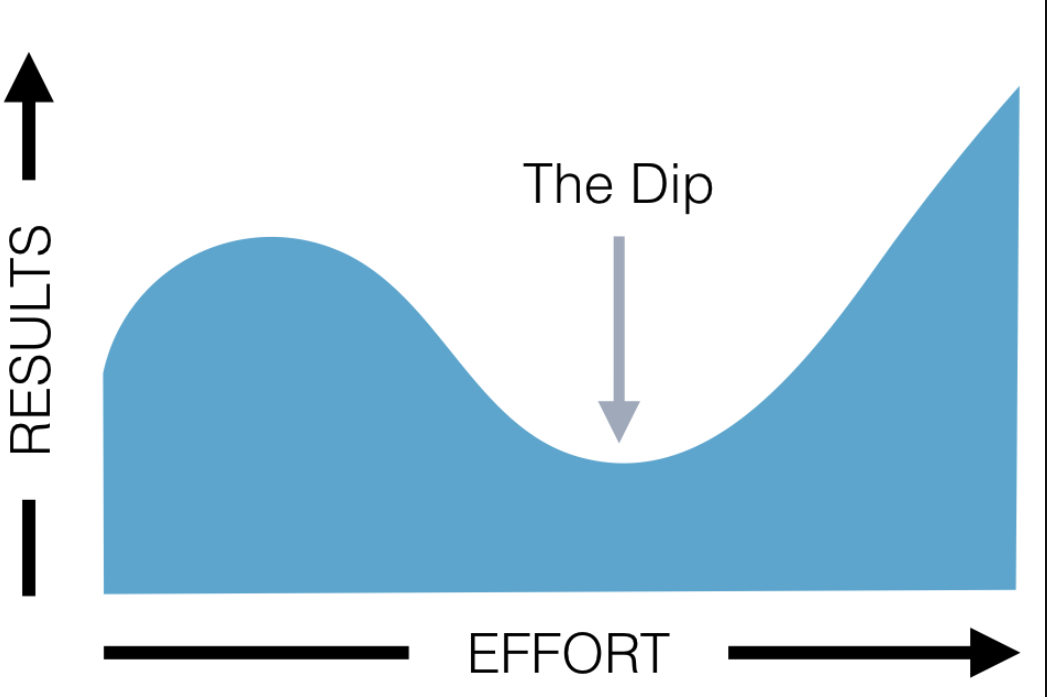
Want to receive my newsletter every week? Subscribe here. I’ll send you one newsletter a week that’s an energy jolt to you and your business. No fluff, just proven techniques for increasing your resilience and performing at your highest level.
Today we’ll discuss when you should give up, and when you should push through.
I’ll share how I discovered this process and explain how you can apply it to your life as well.
The movie American Gangster was released in 2007, the same year I moved to New York City.
I bought a bootleg copy from my barbershop.
And while the video quality wasn’t that great, I did pick up on a valuable lesson from one of the main characters. “Quitting while you’re ahead is not the same as quitting.”
The Dip by Seth Godin was also released in 2007.
In it, Godin teaches that the path to success involves pushing through tough, challenging times (the dip) while strategically quitting endeavors that don’t have long-term potential.
Today, at a glance:
- Discover when to push through or quit strategically to align with your long-term goals.
- Apply these insights across work, personal growth, and creative pursuits for steady progress.
- Refine your focus and performance by regularly reassessing where to invest your time and energy.
Read time: 5 minutes
Embrace the Dip
In his book, Godin highlights how success often comes after enduring a period of difficulty or stagnation, known as “the dip.”
This is the phase where most people quit, but those who push through are more likely to reach exceptional results.

I’ll share an example of how this helped me build my speaking career.
When I started out I was extremely unpolished. After delivering a keynote at Amazon one attendee came up to me and said “Wow, that was great. I can tell you’re not a professional speaker, but that was great!”
This was confusing to me since I was somehow honored and offended at the same time. But one thing was clear, I needed to step my game up.
Instead of quitting, I volunteered to speak for free in the NYC area so I could hone my skills and become a better speaker.
This year I spoke in front of 8,000 people at HubSpot’s INBOUND conference and nobody told me I didn’t sound like a professional speaker so I’ll count that as a win.

When to embrace the dip:
The dip is worth enduring when your effort is focused on something that truly matters and offers lasting benefits.
If the challenge is a temporary hurdle in a meaningful pursuit, and success on the other side will set you apart or lead to significant growth, it’s worth persisting.
Quit Strategically
Knowing when to quit is just as important as persistence.
Godin emphasizes that it’s wise to quit pursuits that don’t offer long-term potential or are dead-ends, allowing you to focus your efforts on what truly matters.
Here’s how I applied this guidance.
I made the decision to drastically pull back on offering coaching and consulting services this year, and now I only work with one client per month
Although I enjoy it, helping clients is very time consuming and it distracts me from my career as an author and speaker.
Plus, three of my kids are now getting homework assignments at school, which means I have to block off even more time to support them.
I also need to learn how to do “new math” since apparently you’re not allowed to just say 4×7=28 anymore.

Even though it was generating income, I decided to quit coaching to focus on more promising revenue streams with better long-term potential—and to invest time in learning math.
When you should quit strategically:
Quitting frees up your energy and focus to invest in more meaningful, high-potential opportunities.
You should quit strategically when the pursuit no longer aligns with your long-term goals, offers little potential for growth, or when the effort invested outweighs the possible rewards.
Be the Best in Your Niche
What’s the benefit of embracing the dip or quitting strategically?
The goal is to aim for excellence in a focused area rather than spreading yourself too thin.
By surviving the dip and becoming the best in your niche, you set yourself apart from the competition and create greater opportunities for success.
This post from Dan Koe was a real eye opener for me.

If you’ve been following me on LinkedIn, you’ve probably noticed that I recently introduced the concept of The Savage Life.
Whether you have or not, here’s my definition of a Savage and how I’m leveraging it to become my own niche.
Savage (noun): A person who is fearless, bold, and unapologetically confident, moving with a sense of purpose and integrity. Often willing to do what others shy away from to aggressively claim the life they deserve and inspire those around them.
Going forward the majority of my content will be focused on how I live The Savage Life, and how you can unlock your savage alter-ego as well.
In essence, I’ve created my own niche, a savage one.
How to become the best in your niche:
Prioritize quality over quantity, seek out feedback to refine your approach, and find a way to differentiate yourself from competitors. This differentiation will most likely be related to your personality or experiences, not just your talent.
To become the best in your niche, you need to consistently focus on improving your skills, have a high level of self-awareness, stay deeply informed about industry trends, and deliver exceptional value.
Terry’s Recommendation Zone
The Dip came out in 2007. Back then I was still in my 20s and had plenty of time to read, especially on those long subway rides. These days I work from home and spend lots of time doing fourth grade homework, so it’s challenging for me to carve out space for self-education.
That’s why I’m glad I discovered Shortform. It’s an easy way to learn ideas from all those books you’ve always wanted to read. Whether it’s self-improvement, business strategies, or personal growth, Shortform delivers detailed, in-depth summaries with actionable insights you can apply right away.

In my case, I used Shortform to refresh the lessons from The Dip, and it even includes activities to help you apply what you’ve learned.
Now, while Shortform isn’t a replacement for reading full books, it’s a fantastic way to explore key concepts and decide if a deeper read is worth your time. You can even start with the audio version so you can listen and learn on the go. Ready to get started? Use my exclusive link below to get 20% off your Shortform subscription today.
That’s it for now, but here’s a quick recap:
- Embrace the Dip when pursuing meaningful goals that offer lasting benefits and significant growth on the other side.
- Quit strategically when a pursuit no longer aligns with your long-term vision or the effort outweighs the rewards, freeing up energy for better opportunities.
- Focus on becoming the best in your niche by consistently improving, seeking feedback, and leveraging your unique experiences to stand out.
- Consider using Shortform to quickly explore key ideas from books when you’re short on time, helping you decide if the full read is worth the investment.

Find me on LinkedIn, YouTube, Instagram, or book a 1:1 call.
Forwarded this newsletter? Sign up here.

